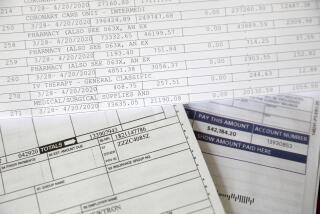Healthcare spending eases off
- Share via
WASHINGTON — Government figures released today show that Americans may be getting a respite from the torrid pace of increases in healthcare spending, but experts cautioned that it was too soon for a national sigh of relief.
The data show that in 2005, spending on healthcare grew 6.9%. That was the smallest rate of increase since 1999, and marked the third straight year in which the pace had moderated. In 2004, for example, spending grew by 7.2%. Because of the time required to collect and analyze data, the 2005 numbers are the latest to be released.
Although the rate of increase declined, healthcare spending in 2005 still grew faster than wages, inflation and the economy as a whole. And with employers continuing to shift more of the cost of job-based medical insurance to workers, the pressure on individuals and families remained high.
“It would be a disaster if people thought these [spending] numbers mean the crisis is over,” said Henry Simmons, president of the National Coalition on Health Care, which advocates for covering the uninsured. “Even if costs are only going up at 6.9%, that is still two or three times the rate of growth in take-home pay. It is still unsustainable.”
Said economist Joseph Minarik, “I suspect that what we’re seeing is something like we observed in the early 1990s, that as costs go up some resistance is being thrown in their path. But the resistance is not a fundamental change, and the fundamentals in the system will continue to push costs higher.”
Minarik is a senior vice president of the Committee for Economic Development, a group of chief executives that tries to influence public policy on major issues.
Nationwide, health spending reached nearly $2 trillion, accounting for 16% of all economic activity and averaging $6,697 for every man, woman and child, according to the figures released by the Department of Health and Human Services and published in the journal Health Affairs.
A slowdown in spending on prescription drugs was the main reason for the improvement in 2005, the government report found. Analysts credited a continuing shift to generic medications, as well as aggressive cost-control efforts by state Medicaid programs. The report did not factor in the new Medicare prescription benefit, not yet in effect in 2005.
Government experts also found another glimmer of hope in an arcane but important statistic that measures the amount of spending on the sickest people. Traditionally 5% of patients -- the most frail -- have accounted for more than half of all spending in any given year.
But in 2003, the share of spending on these very ill patients dipped to 49%, suggesting that doctors are reducing costly hospitalizations through better management of chronic diseases such as diabetes.
“It’s nice that overall health costs have slowed down a little,” said Richard Foster, Medicare’s chief number cruncher. “It’s nice that the economy is doing well. It’s a happy occurrence. [But] it’s not something we can expect to happen all the time.”
The release of the numbers, an annual snapshot of the healthcare system, coincides with Gov. Arnold Schwarzenegger’s call for broad healthcare reforms in California. He is the second GOP governor to engage in a major effort to cover the uninsured and rein in costs. Last year, then-Massachusetts Gov. Mitt Romney pushed a plan through in his state that requires all residents to get coverage.
Nationally, the number of uninsured stands at about 47 million, as government programs have failed to keep up with the continued erosion of employer-sponsored coverage. The share of employees covered on the job fell from 81% in 2001 to 77% in 2005.
The federal cost report also came on the heels of a study that found the United States spends far more on healthcare than some of its closest economic competitors in the global marketplace. The U.S. spent more than 2 1/2 times as much as Japan per person, and a little less than twice as much as Germany. Both those countries cover all residents. The analysis, for the Kaiser Family Foundation, used data from 2003, but experts said the pattern has not changed.
“The Europeans are worried that with their current rate of growth, they are going to be spending 12% of their gross domestic product on healthcare, but for us 12% would be a miracle,” said researcher Gary Claxton, author of the Kaiser study. Higher healthcare costs translate into higher prices for some U.S. goods and services, making them less competitive both at home and abroad.
*
ricardo.alonso-zaldivar@ latimes.com
More to Read
Inside the business of entertainment
The Wide Shot brings you news, analysis and insights on everything from streaming wars to production — and what it all means for the future.
You may occasionally receive promotional content from the Los Angeles Times.










